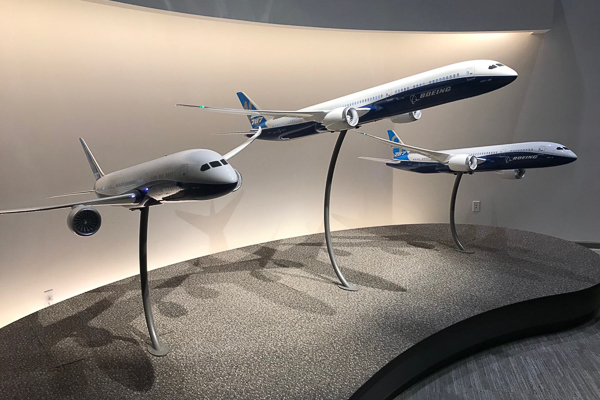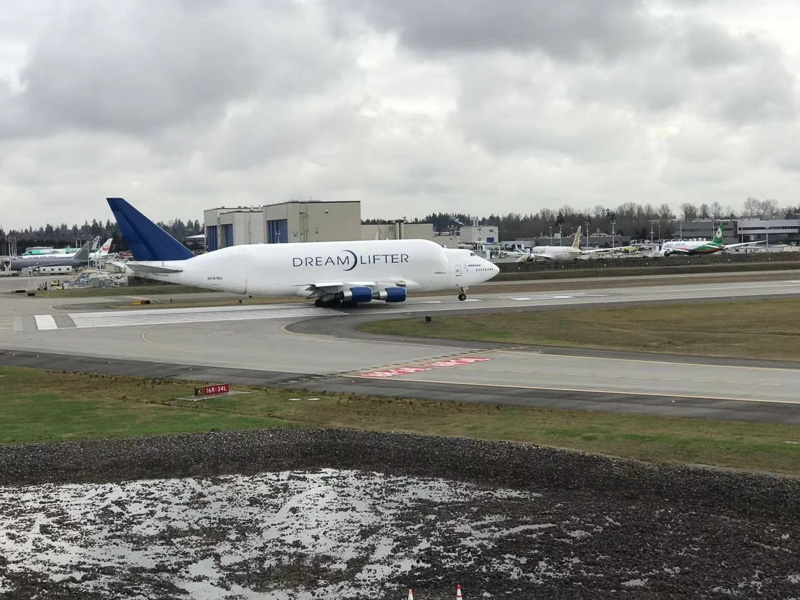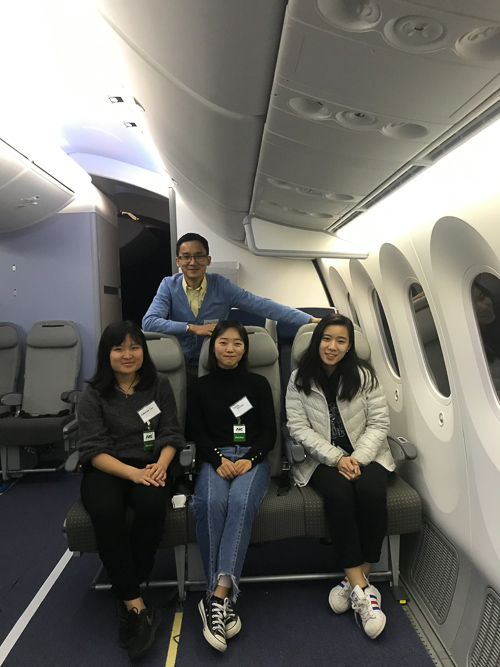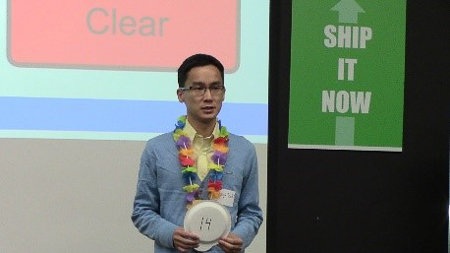Representing Cornell at the first Boeing Innovation Challenge

By Weiyi Shi, Two-Year MBA ’19
A group of Cornell students had the opportunity to spend a fantastic five days in Washington state for the Boeing Innovation Challenge hackathon. Students from Cornell, the University of Washington, and Georgia Tech were invited to Boeing’s commercial airplane’s development site in Mukilteo, WA, to brainstorm ideas about disruptive mobility, passenger comfort, and operational efficiency.

Unlike students from the University of Washington and Georgia Tech who were more engineering-oriented, Cornell teams had representatives from not only the mechanical engineering field, but also Johnson, the Dyson School, the Nolan School of Hotel Administration, and the College of Human Ecology. During the hackathon, students were supported by a group of Boeing professionals with backgrounds in engineering, business, finance, and regulation. We were also provided with a great variety of tools, access to a mock cabin, simulation data, and even computer-aided design software. Student groups presented their ideas and a minimum viable product (or MVP) to a Boeing judges’ panel at the end of the hackathon. One Cornell team walked away having won recognition for the Most Innovative Idea.
Landing in Seattle, the “Emerald City”
Boeing arranged for students attending the event to stay in a hotel within a stone’s throw of the Paine Field airport, where every single new B747 took off. My room was directly facing the runway threshold, and I heard roaring engines at 5 a.m. following days when Boeing Dreamlifter departed to Charleston, NC, to ferry major assembly of B787s. It was noisy, but no complaints from an aviation geek’s point of view!

The trip to Boeing started with a dinner at the Flying Heritage hanger where Paul Allen’s collection of rare military aircraft from the United States, Germany, Japan, Russia, and the UK are parked. It is such a unique experience to dine in among superstars of air combat! A lot of Boeing executives attended the dinner, including the CFO of Boeing Commercial Airplanes, chief engineer of the 747 program, and more. Bret Bolkcom, MBA ’08, director of commercial marketing of Boeing Global Services also attended the dinner and gave Cornellians a very warm welcome. A speed networking session was hosted right before the dinner, so students had the opportunity to introduce themselves and ask questions to Boeing executives.
Sell your idea, but always keep the business model in mind
The hackathon officially kicked off on a Monday morning. Each finalist team presented their incredible ideas in front of all of the students, and we were encouraged to form a new team for the idea we are interested in working on in following days. Actually, every team was required to include a team member from another school. Boeing believed that it was essential for us to practice selling our ideas throughout the event, and having team members we were not familiar with helped us jump out of the box and spark greater discussions and greater ideas!
We spent time at Boeing’s Airplane Integration Center, where airplane customers work with Boeing to provide a better experience for air passengers. Boeing offered us access to B777X and B787 cabin mock-ups and explained how the latest models differ from earlier ones in terms of passenger comfort or operational efficiency. We were also provided a workshop and used a great variety of tools to do prototyping. Depending on the ideas, I believe each team more or less utilized the workshop to some extent—it was a great fun!

Every afternoon shortly after lunch, we were asked to do a stand-up report in the meeting room, reporting on our progress, next steps, and if there was anything we needed help with. Every day there was also a group of Boeing engineers touring the meeting room, discussing our ideas, and most importantly, challenging us in regard to engineering feasibility, regulatory issues, etc. This was super helpful refined our idea and studied the risks and possible mitigations.
On the second day, Boeing invited the financial manager to give us an introductory lesson on valuation. As a Johnson student, I didn’t find this difficult at all! But it was alien content to many of the engineering students in the room, and I was very happy to offer them my version of an explanation for calculating the NPV of the project.
Unlike a few hackathons I’ve attended previously at Johnson, which focus more on investment decisions or conceptual ideas, the experience at Boeing included a lot of consultation with the engineering side of the company. I felt like this may relate more to a real experience as a product manager, who has to put every resource of a company together before figuring out if they have the capability to address a market pain point in a feasible and profitable way.
Putting everything together and our final day
The night before the final day was stressful. We finished our PowerPoint deck by 11 p.m. and did a couple dry runs before we finally squeezed everything from addressing the problem, to the engineering aspect, and to project valuation into the three-minute timeframe. The hotel lobby was full of students from three schools.

On the final day, each team was given three minutes for their presentation and three minutes for a Q&A.
The winning team’s idea was an AI-based diagnostic system that can help the flying crews better handle undesirable situations, providing them with less complex information among major cockpit displays.
The judging panel commented that the winning case was a good example of utilizing technology under development to address current issues. They had a good video demo, and it showed great potential value that it could bring to the industry and the operators.
Innovation Challenge takeaways
I was very optimistic that our team would do great throughout the course, but in the end we didn’t win. This was a bit disappointing considering I have had sound record in the aviation industry before pursuing my MBA, and we put together a really good business case. Looking backward, I think Boeing wasn’t looking for participants’ deep knowledge of any particular issue within the aviation industry, but preferred a more aggressive approach to tackling some of the problems the company is facing at this moment. That being said, Boeing was not expecting a group of students to work for two days to deliver a proposal that could address every engineering challenge and regulatory hurdle while showing promising business value. Even for its own experienced team, this wouldn’t be possible. Boeing was expecting students to give them an out-of-the-box idea—an idea that sounded interesting, not crazily mad, and had some evidence that it may work in the very demanding environment of aviation with a viable basic business model.
I’ve always believed that aviation is a fascinating industry. It is where people are making products that perfectly deliver the beauty of technology and a sustainable business return—some of the most elegant products ever produced.
At this hackathon, I saw why Boeing has been the champion of the industry for a century. It encourages people to try, listens to their ideas, keeps safety in mind, and always thinks forward. It provides a great platform for both engineers and business people to collaborate together so they can understand the needs of market and provide viable solutions.
The three-day event was concluded with a VIP tour of Boeing Everett Factory, the largest building by volume in the world, passing the first delivery of the KC-46 to the USAF, the 747 and 767 assembly lines, the 777 and brand new 777x, as well as the 787 assembly line, with the melody of rivet guns, hammers, and overhead cranes as the background music. The experience is more thrilling than the ordinary tour in which people can only see work from an elevated tunnel.
And so concluded the first-ever Boeing Innovation Challenge at Boeing, where the future is built.
About Weiyi Shi, Two-Year MBA ’19

Weiyi Shi is a second-year MBA candidate at Johnson. He is an aeronautical engineer and worked in the aerospace industry for 10 years. He worked in supply chain management and technical roles in his early career and progressed to sales and a junior management role before coming to Johnson. His MBA studies are focused on operations, finance, valuation, and strategic marketing. Weiyi, who loves cooking, is also a pilot and spends a lot of his spare time flying (as long as the weather is good in Ithaca)!
